Photography
Harbottle Castle, West Wood and Alnmouth: a photography outing
For the first time in quite a while, I get out for a day’s dedicated photography
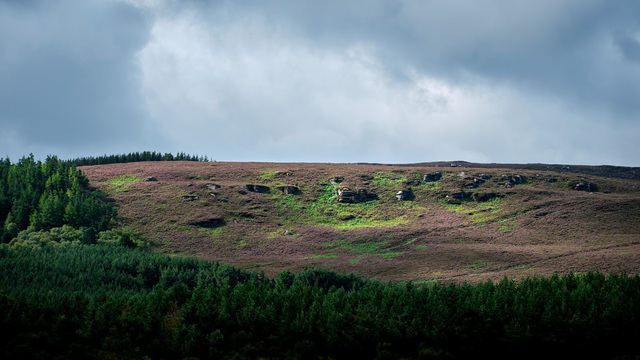
After my mid-year goals check-in, I managed to get out for (most of) a day dedicated to photography on Saturday.
Starting out by heading towards West Wood near Rothbury—a location I had first found a couple of years ago, location scouting for a brand shoot—I first stopped in the nearby village of Harbottle to check out the ruin of Harbottle Castle. After the castle ruins and a couple of hours in West Wood I had some lunch in my car and then made for another woodland, Thrunton Wood. Though by the time I got there I found it very busy and, weary from my morning exertions, decided to change tack and head out to the coast instead: towards Howick and then down to Alnmouth where I finally got some more pictures before heading home.
It was fantastic to get out for some pure photography-and-wandering time and, as usual with these days, so widely interspersed as they are, managed to get a few reasonable images and more new locations to go back to with more time and/or better conditions. I didn’t manage to fly the Mavic but I did expose 5 frames of Provia 100 with the Bronica GS-1.
In this page:
Harbottle Castle
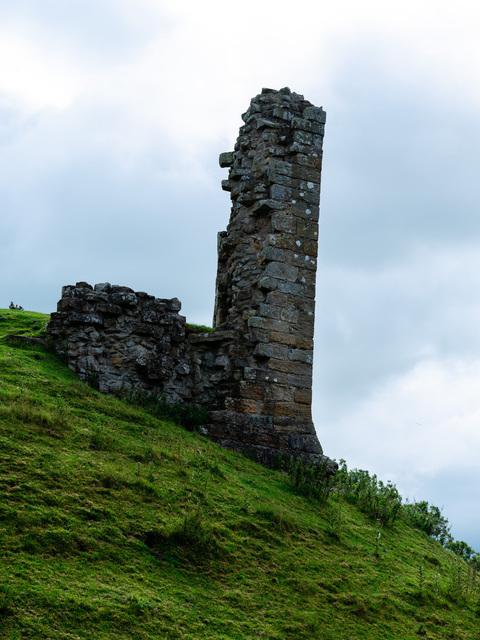
I’ve driven through Harbottle a number of times and vaguely registered there was some kind of heritage-based location to visit without ever giving it much thought, but on this morning for whatever reason, I spotted the sign for the car park and decided to stop. The tiny car park looked new, so maybe that did it.
After a mildly confusing notice about sticking to a track in the lower field and free-roaming in the top, I climbed the hundred-or-so yards uphill to the next gate and there, behind a few large trees, was the ruin (active word) of a castle set atop a couple of hills.
Castle
There’s one taller bit of wall/tower that stands out, and I took a close-cropped image of it on my initial walk around the base of the hill, then made my way around the back and up into the remains of the castle itself, where I took a few shots from the high vantage point of the surrounding hills and village.
Wandering back down and out of the wind, the sun began to peek out from behind the clouds, casting an interesting shadow from the taller wall across the hillside, and I made a quick hand-held panorama. I had the GF100-200mm on the GFX 50S at the time and no time to change lenses, so it had to be a panorama stitch.
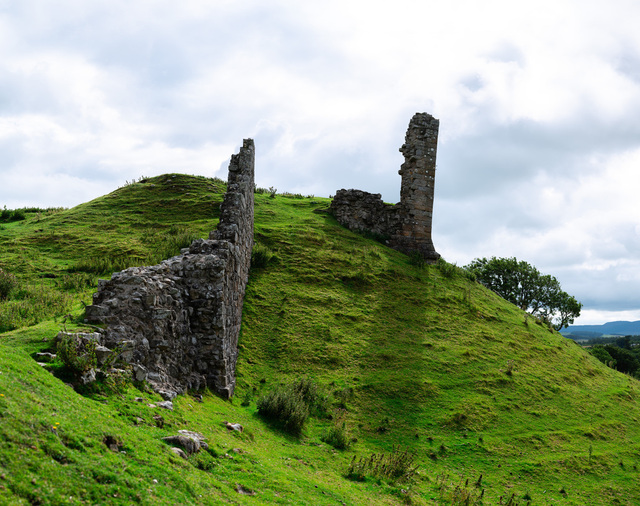
As I made my way back towards the gate to leave, another burst of sunshine came through and a second pano from further back gave me my favourite image of the three: a more ‘panoramic’ pano with a wide aspect taking in the second hill and more of the ruin for a better context-setting composition with nicer light.
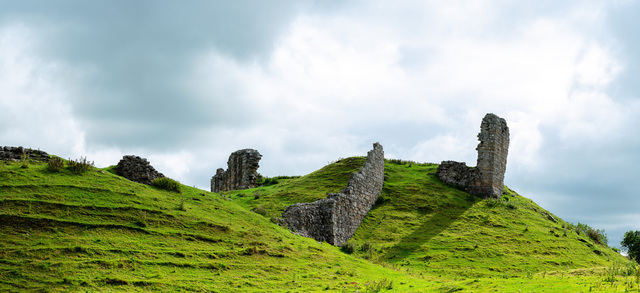
Hills
Harbottle is surrounded by heather moorland and the colour was already starting to come out quite strongly so I did get a few variations on the view from the castle out over the hills.
First up, a couple of frames including the castle wall for foreground interest:
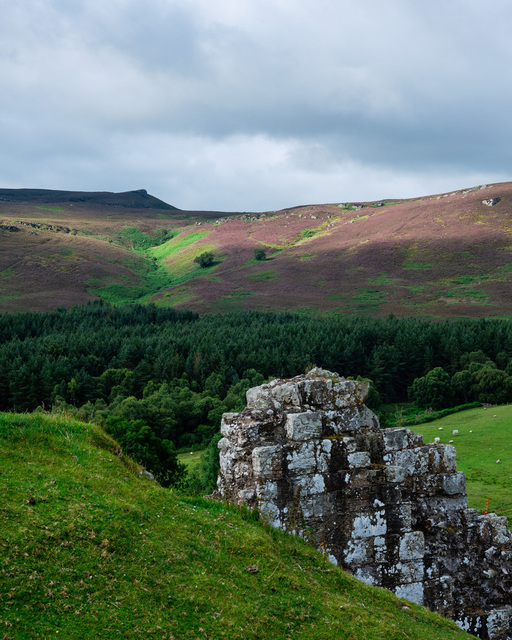
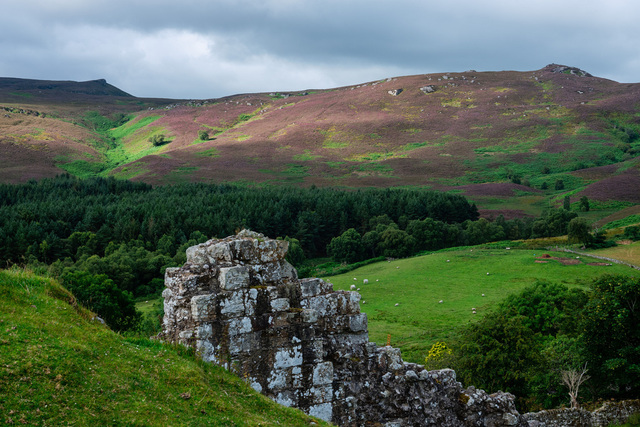
And then a couple catching the light rolling over the hills, picking out different details second-by-second…

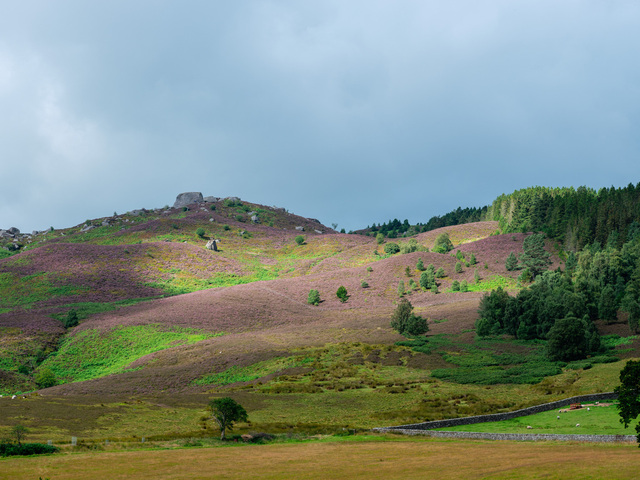
Finally, a more moody image as a small patch of light broke through the clouds to the left of me at one point.

Trees
As you come through the gate to the ‘top field’ where the castle lies, there’s a short run of lovely old trees to your left and I couldn’t help but take a couple of quick photos.

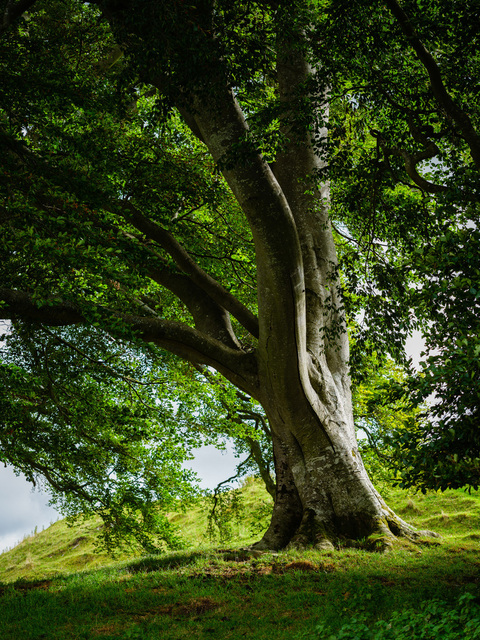
Harbottle
To round off the first stop of the day, a (rather experimentally composed) panoramic shot looking down over the village of Harbottle and out into the hills.
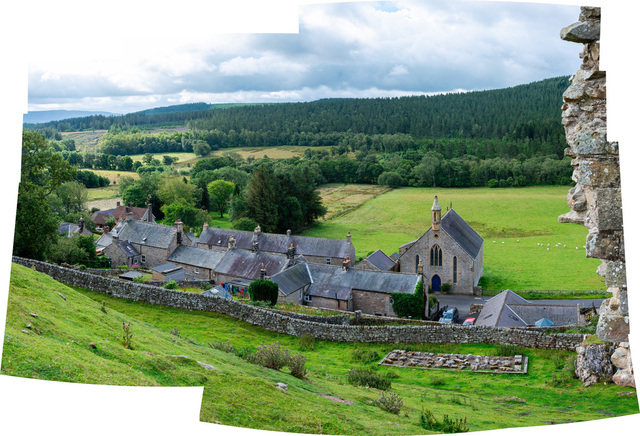
A few months ago I shared a stitched close-up image of a Vincent Grey Flash motorbike from the Goodwood Festival of Speed, where I had ended up taking some overlapping images at different angles that created a rather jauntily-edged ‘panorama’. In that case, I liked the almost graphic design feeling of the composition.
“The bike itself is lovely, and the light is good, but what I’ve always enjoyed most in this image—and thus never ‘corrected’—is the off-angle, overlapping composite stitch.”
Stitching together the larger set of frames—the motorbike was stitched from just 3—I took to cover Harbottle village and its surroundings, as with all pano stitches I got a bunch of odd edges as Lightroom warps and rotates images to get the right stitch.
And I liked the result!
Again with this image, I actually think the irregular edges aid the composition in a weird way.
One obvious view to take would be to say that I didn’t pay enough attention to the edges I needed for the final stitched image and now I don’t have enough of the castle wall or the lower left area of grass (the sky is easily filled in).
I could try to crop in from what I have (I did), losing foreground and a lot of the castle wall. This way just leads to a compromised composition, so it’s out.
Back to the first thought then: capturing more of the missing bits.
Firstly, yes, I totally didn’t pay much attention to my edges when taking the frames in the field. That aside though, I think a standard frame with the extra info filled in might actually lose some of the sense of depth the image has with the sides of the frame leaning in.
I like that the right edge of the un-fixed pano above has a jagged effect that mirrors the castle wall it runs along, while the others that bound the natural scenery are more curved.
I’m sure I’m just post-rationalising my ‘save’ of a flawed panoramic, but a bit of creativity doesn’t hurt now and then, and in this case I do quite like the result.
Anyway, from Harbottle Castle I jumped back in the car and drove (pretty much literally) around the corner to my original destination…
West Wood
Things here began well, with this lovely little scene immediately in front of my parked car:
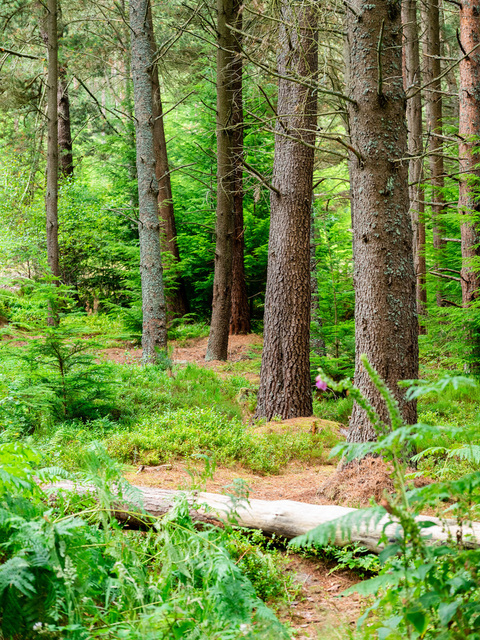
After a quick bite of breakfast in the car, I gathered my gear and began the walk up the track from the car park into the woods.
Not ten yards past the gate and I did a double-take as something on the ground caught my eye. A snake! In England!
Having looked it up back at home, I find it was actually a slow-worm (a ‘legless lizard’ rather than snake, for those interested) but still the first snake-or-snake-like creature I’ve encountered not in a zoo.
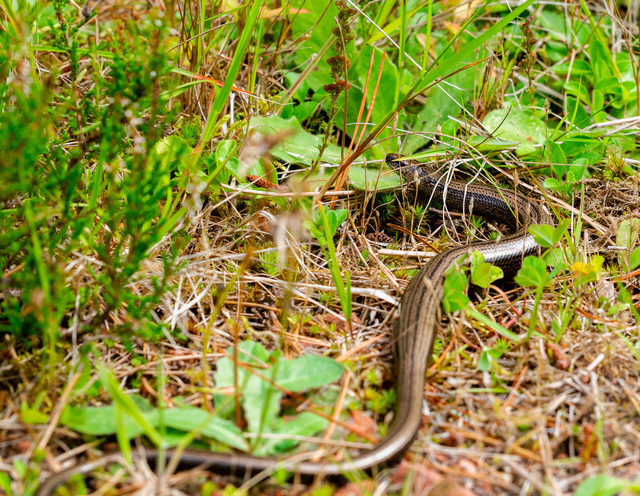
It didn’t move off too quickly, so I could crouch down and take a couple of images to document the occasion though I didn’t want to get overly close and spook it. Eventually it slowly slithered into a small bush and I wandered on, still somewhat surprised.
Overgrown paths, and lost again
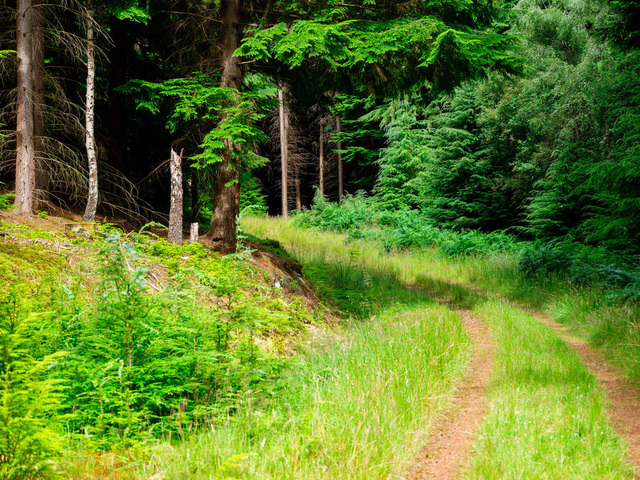
The track up the hill was a bit like something from a post-apocalyptic movie: totally overgrown with a sense of nature beginning to reclaim even the narrow tracks.
With the state of the world, I assumed the wood just hasn’t seen much human activity in recent months and carried on along the broad, slowly-winding track, enjoying the sunshine.
The first time I visited West Wood, I was simply trying to get through it to the heather moorland of Barrow Knocks, which I had spotted from the road and missed an easy route up to.
Instead, I’d focused on parking safely, found the nearby West Wood car park and attempted to simply walk through the wood to the hills I had seen on the other side. Leaving the track at the first bend and carrying on straight, I quickly got bogged down in dense, tangled ferns on steep hill and ended having to jump a fence and a wall on the other side to get back out again.
Little did I expect that this day would end much the same way…
“I think the moral of this story is to approach ventures into the countryside more seriously: get good Ordnance Survey (or equivalent) maps of the areas you're scouting and do a bit of prep beforehand.”
If only I had listened to my past self, summing up my first encounter with West Wood by warning to check maps before heading out into the countryside.
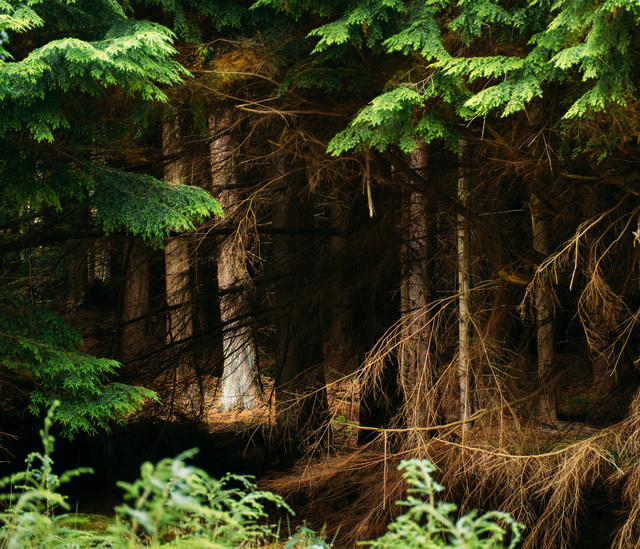
This trip had ended up being a little short-notice and so I hadn’t done any prep and instead just come back to West Wood aiming to follow the proper track this time.
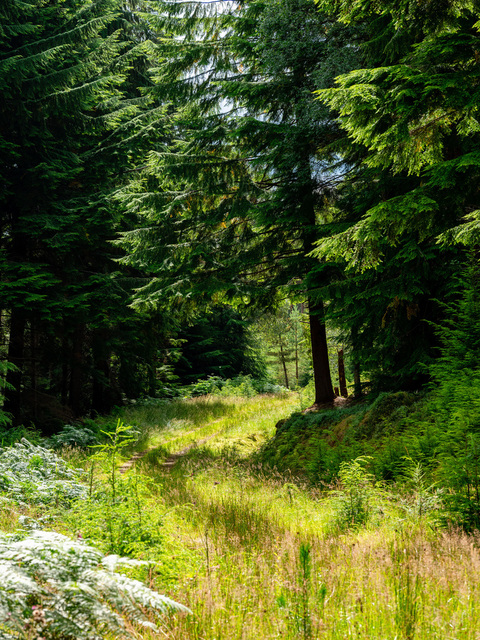
As I walked, the track got more overgrown until it eventually dropped down to a single foot-beaten path further into the woods, occasionally blocked by fallen trees. Again, I naïvely assumed that the paths just weren’t being cleared during lockdown and carried on around any blockades.
Eventually, the path ran out, blocked by too large a fallen tree.
A bit confused, and assuming there must surely be a route further into the woods, I ducked under the canopy and through the trees for a short while before deciding that no, the track really did just end and this isn’t one of those woods with nice paths to follow. It is in fact quite wild and difficult to traverse.
It’s at this point I really should have turned back to my car, and I thought about it before spotting a drystone wall on the edge of the wood a couple of hundred yards away.
For some reason, I decided to bushwhack my way over there and investigate, which led to then trying to follow the wall from within the dense wood and of course, before long, being too deep in for comfort and very tired.
I had stopped looking for compositions a while ago now, and just wanted to get to a path or track of any sort, then head back to the car for some food and a rest.
My low mood certainly wasn’t helped by being constantly swarmed by flies in the dense undergrowth.
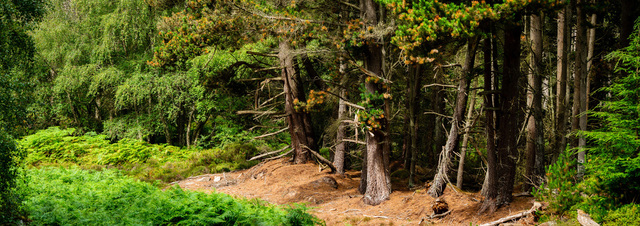
After a while, I gave up on trying to stay high and close to the wall, instead tracking downhill in more of a straight-line direction towards the bottom of the wood and my car. As it turned out, I had already gone most of the way across the top of the wood and soon encountered my old enemy, the deep ferns.
While disheartening, this was at least familiar and so I stayed just above the line of the ferns and headed for what I knew would be the edge of the forest and another exit over the fence and a wall-jump into a ditch. In the immortal words of Battlestar Galactica, “all of this has happened before, and all of this will happen again.”
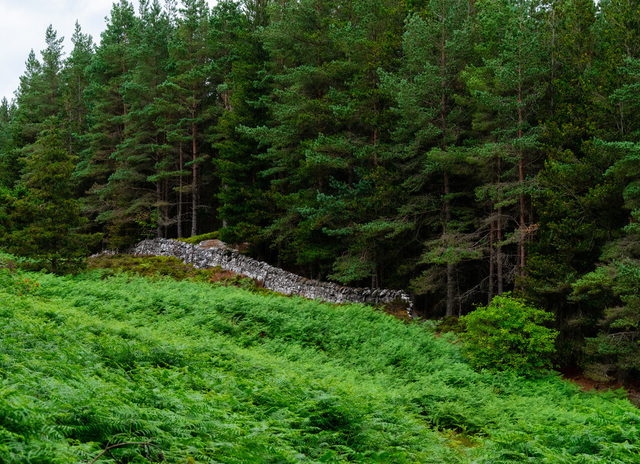
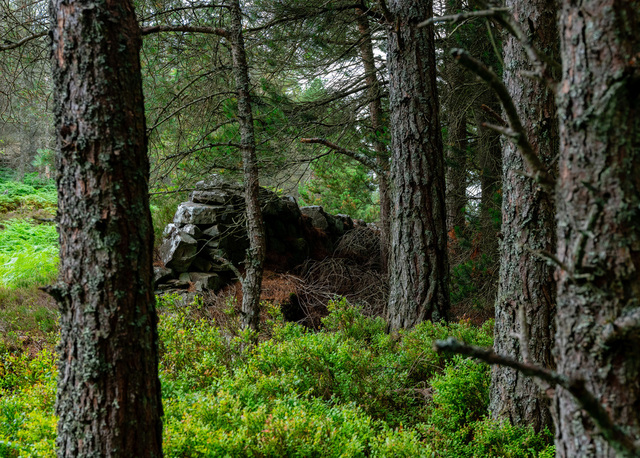
Freedom
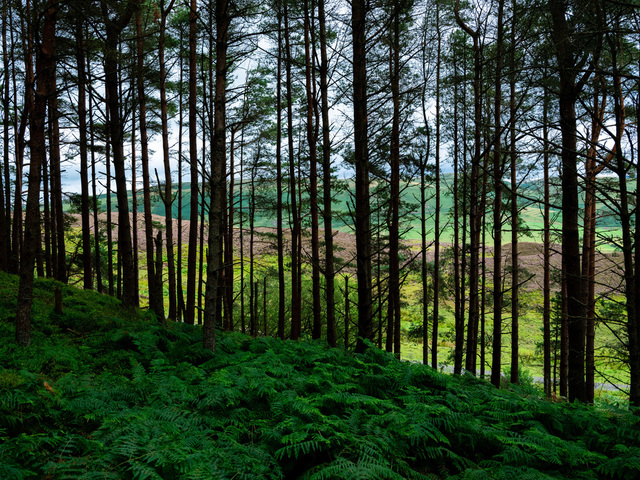
Finally, I found the edge of the forest, found a low point in the fence I could step over and then the least-dangerous point to jump down from the drystone wall into the ditch on the other side when carrying a very heavy pack of camera equipment.
After a failed attempt at sitting down on the path the other side for a rest (swarm of flies again), I walked back to my car as quickly as I could, to collapse and eat some lunch then have a short rest before heading elsewhere.
Thrunton Wood
Exhausted, but with some food and hot tea consumed, I decided to move on to nearby Thrunton Wood for the time I had left in the afternoon before getting home to make dinner for the family.
I’d never been to Thrunton Wood, but had it marked as somewhere to check out and so I drove over as it was nearby.
By the time I got there however, I found it packed with cars and realised looking at maps that it would be a long-ish walk to any points of interest. Neither the walking distance nor the large numbers of other walkers were particularly enticing by now, so I fell back to my other option: driving due East, out to the coast, and spending whatever time I had left meandering down the coast road looking for points of interest.
I aimed for Howick and set off.
Howick
As it happened, Howick was a no-go. There was some kind of youth adventure sports event going on and so the area was thronged with kids in wetsuits changing by their cars, and nowhere to park.
I set back off down the coast, cutting out to the sea where I could find access roads with little success. At one point I stumbled onto a little track that ended at a beach near Seaton Point, so I got out for a quick look and found it was the entrance to a small caravan park, while the beach was pretty flat and uninteresting for a quick visit.
I did snap an old emergency telephone box though, which turns out to be one of my favourite images of the day.
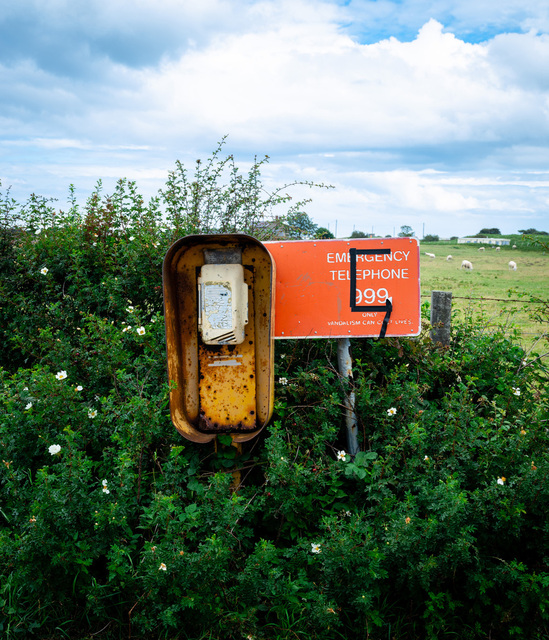
Lesbury and the River Aln
Carrying on along the coast a little further, the road climbed and the view opened out over a horseshoe bend in the river Aln below. Spotting a small lay-by next to a stile for a public right of way down the hill, I pulled over and went to investigate.
The view is impressively panoramic in real life, though the actual panoramic I took hand-held isn’t quite so. It’s a useful reference shot however, with details to pick out and maybe return to with a longer lens if I’m passing this spot again.
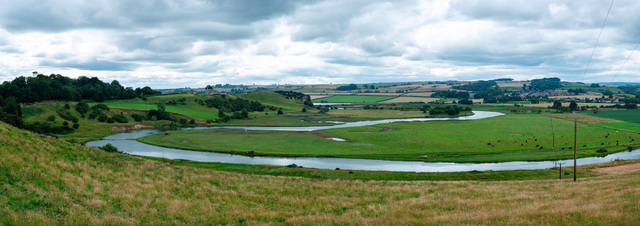
One such detail I’ve spotted after the fact is a little cottage set right down on the river plain at the base of a hill:
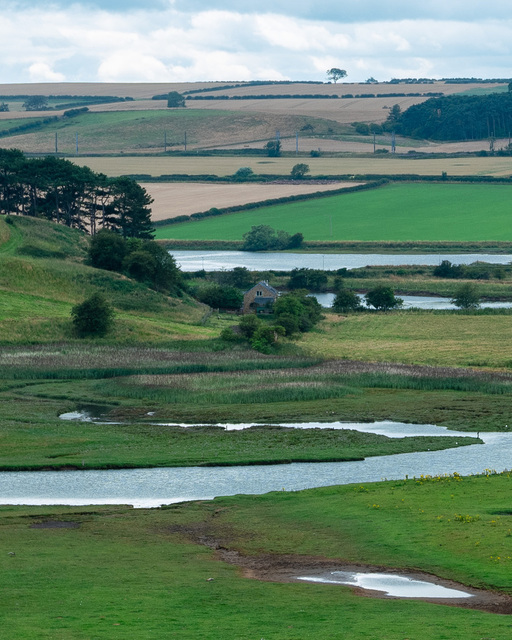
This is one of the wonders of the 50MP GFX system: the ability to crop right in on wide shots and still have solid detail.
The above crop is too small to print for example, but has plenty of detail to act as a reference for a future shot at a longer focal length.
Alnmouth
From a view over the Aln, I carried on into Alnmouth village itself: a beautiful little coastal village at, unsurprisingly, the mouth of the river Aln.
I’ve visited Alnmouth quite a few times, for walks on the beach and for the lovely Sunday roasts at one of the local pubs. Today, I carried on through: the village was busy and I didn’t have a huge amount of time left.
Winding out and up the other side of the shallow river valley, the view back across towards Alnmouth and the sea was striking so I started frantically looking for somewhere to park, eventually turning round and heading back down to the outskirts of the town, ready for a short hike back up the road.
Arranging equipment in the boot of my car, I decided at last to bring out a film camera—the medium format Bronica GS-1 6x7—as well as the digital medium format Fujifilm GFX 50S.
On the Fuji I mounted the GF100-200mm telephoto lens (~79-158mm full-frame equivalent) as I knew I’d want the reach, while for the GS-1 I currently only have the 150mm F4 lens (~75mm full-frame equivalent).
After a rather hairy trek up the narrow, winding road with very little grass verge to avoid oncoming traffic, I eventually found a gap to get over onto the bridleway and start looking for a composition, which presented itself soon enough.
Setting up
Having switched to my smaller Lowepro 500AW backpack rather than lug the huge Atlas Adventure on such a short jaunt, I also had my lightest tripod with me: the 3 Legged Thing Albert. I did worry a little about stability with two big camera/lens combos (more with the GS-1), though it had handled the 50S/100-200 combo just fine in the Alps and did so again here.
After setting up the tripod, I mounted the GFX 50S and began with a super-wide panoramic, taking in the full width of interest in front of me from the bridge over the river, out to the sea.

This resulted in a quite extreme 6.4:1 ratio panoramic image after having Lightroom stitch all the images together: a ratio that is pretty much useless on even very big screens but atrocious on small devices. It could be lovely as a huge print though, especially with so much detail to the image: the original is a 335MP monster!
Within this view, I found three main areas of interest: the bridge on the far left, the colourful row of houses in the middle and the mouth of the river on the right, with the cluster of houses on one side and dunes/hills on the other.
The bridge
First up, the bridge which I captured twice: once at the start and again, around 20 minutes later before I started heading back to the car.
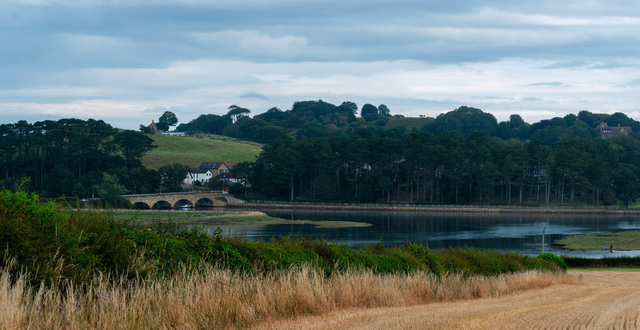
The first composition is another pano stitch taking in the bridge as well as some of the river and the tall trees lining the river bank, as well as some of the wheat field in the foreground.
This sets the scene reasonably well, but isn’t a great composition overall. The wheat field is the brightest element in the image, drawing the eye, while its diagonal edge also draws you out to the right and off the edge of the frame rather than into the bridge.
The later composition is a single frame, cropped slightly to focus more in on the bridge and the white building behind.
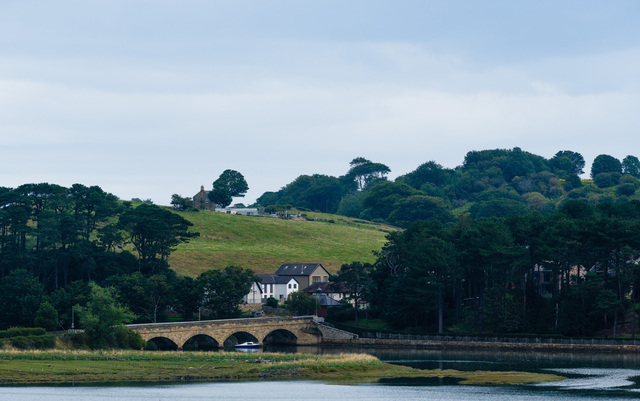
I’m actually less sold on this composition (even though my wife just walked by as I write and commented on how nice it is).
In order to remove the distracting foreground hedgerow, we’re left with just a thin sliver of bright water at the bottom that I may yet go back and crop out. The reason I left it in was to give some space at the bottom of the frame for the boat fishing under the bridge to breath.
Meanwhile on the crest of the hill, above and behind the white house, is a messy construction site that I can’t un-notice. Maybe I’ll return one day and work on the composition a bit more in the field, trying new angles, as I do think there’s something here.
A burst of colour
Panning across the view in front of me, a colourfully-painted row of houses on the far bank stood out with a ton of character.
I love when you get these rows of individually-coloured old houses in a terrace and with the relatively dull conditions the colour was a welcome pop of interest.

Again, compositionally I could do without the power line and pole running through the foreground. I could have a go at removing it in Photoshop, but it’s neither glaring enough nor the overall image exciting enough to encourage me to spend the time just yet.
River meets sea
The last of my three compositions from the same spot is the one that caught my attention from the road: looking across the field at the village sitting on the mouth of the river opening into the North Sea.
The houses stacked up and down the hill give a lovely depth to the village, while the boats moored in the river add another layer of interest. There’s the power line problem again, though not so centrally, and I love the sandy dunes on the near bank at the mouth of the river, as well as the round hill, which have a wilder feel set against the old village.
I took two variations on this composition and tried two slight variations in processing too.

First, a frame that cuts more from the left, keeping just the main bank of old buildings in the village and a little more of the opposite bank. Processing-wise, this one has stronger contrast—the same core set of edits as the other images from Alnmouth—while the second, taken 10 minutes later, goes wider and I tried a lower-contrast approach based on one of my oldest Lightroom presets that I hadn’t used in years.
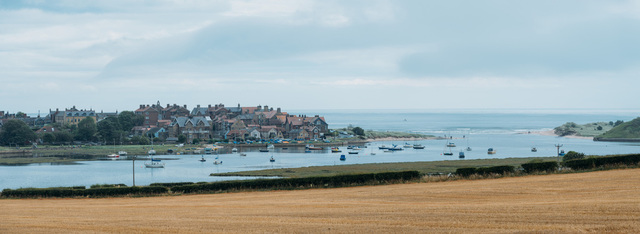
As I’m writing, I prefer the first image. While I was processing, I preferred the second. Who knows which I’ll prefer given a bit more time and returning with fresh eyes.
Bronica GS-1
I mentioned taking the Bronica with me for this location, and I did indeed finally expose some film: 5 frames of Provia 100.
Unfortunately, that’s only half a roll and I haven’t had opportunity since to finish it, let alone send off to be processed. The test roll I recently got back from Digitalab confirmed the camera is working well and the images look super sharp under the loupe (I haven’t had time to scan them), so I’m actually quite keen to see how the images from this location turn out.
An interrupted dash to the car
By now, I really needed to get back to my car and on my way home in order to cook dinner for the kids. Caution got the better of a return trip walking down the country road however so I followed the longer route along the bridleway, which cuts in towards the river before joining back out to the road near the bridge.
On my way, a couple more interesting angles opened up and I got three more hand-held images to round out the day.
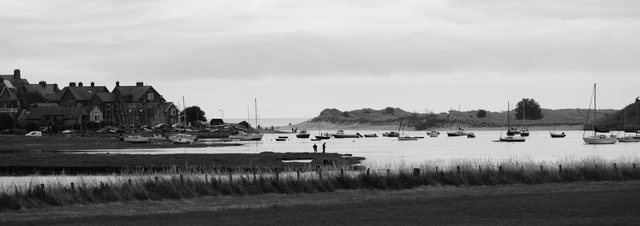

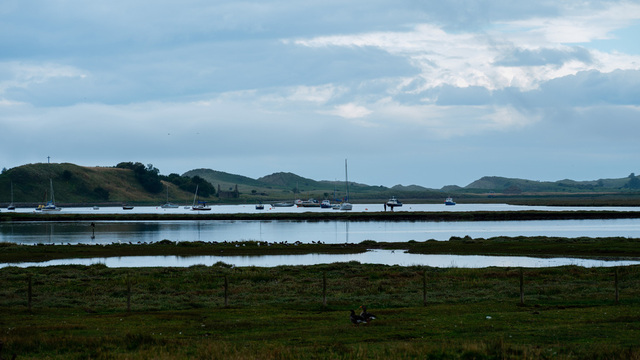
Closing thoughts
As always when I manage to get out for ‘proper’ photography days, I thoroughly enjoyed myself. While I didn’t get any portfolio-worthy images, I experienced a lovely day of exploring and photographing; I found some interesting compositions that I’ve now got logged in case I’m nearby again with good conditions, and it also acted as a good testing session for SceneMapper, my ever-in-progress location scouting app for which I found some good optimisations to apply as well as a couple of interesting new ideas to add to the list.